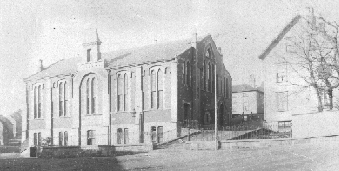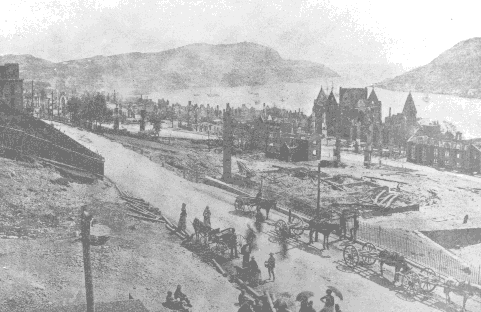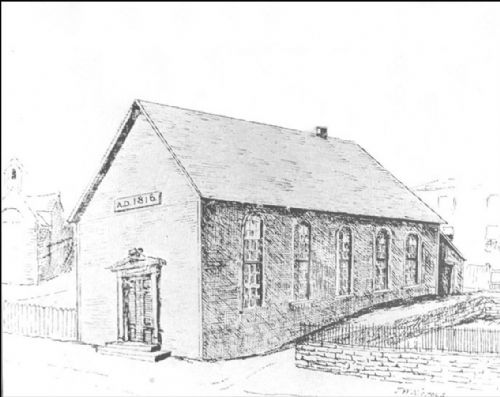A Brief History of Gower Street United Church
Introduction
Gower Street United Church (formerly Methodist) is the oldest congregation of the denomination in St. John’s. Established in 1815, it has been a major social and religious force in the city for more than 200 years.
The present church building was opened in 1896. It is the fourth for the congregation and the third church on the present site. It was built to replace its predecessor, which was burned together with much of the city in the Great Fire of 1892.
The main church building is of a modified Romanesque architectural style, designed by Elijah Hoole of England. He was the architect of many churches throughout the British Empire in the nineteenth century, though only two were built in North America: Gower and George Street United, also in St. John’s. Gower’s basic architectural features have remained largely unchanged and include three levels of seating, a ceiling of inlaid wood supported by heavy hammerbeam-type arches and trusses, with ornate woodwork and iron grillwork throughout. In more recent years, more than 50 stained glass windows have been installed, the largest of which is a rose window by a local artist, rich in symbolism associated with the church and its Newfoundland and Labrador social context.
Gower Street United Church has been designated as a Registered Historic Structure by the Heritage Foundation of Newfoundland and Labrador, and is one of the four churches within the Ecclesiastical District National Historic Site of Canada.
Today, Gower is a vibrant and inclusive downtown church, involved in the community and determined to meet the challenges of living the Gospel in a modern world.
Early Roots
Gower is the oldest congregation of the United Church of Canada in St. John’s. It was founded in 1815 as a Methodist congregation and became part of the United Church of Canada in 1925 when that church was founded by the union of the Methodist Church, Congregational Church and some of the Presbyterian Church.
Gower’s pioneers for the most part had moved into St. John’s from nearby Conception Bay where Methodism had begun soon after the Wesleyan movement made an appearance in England in the 18th century. At first they had participated in the local Congregational Church but by the early 19th century, they were beginning to feel the need for their own church and their own minister. They requested the Methodist Church in England to send them a minister, and in the meantime, in June, 1815, they began work on a small chapel several blocks to the east of the site of the present church. In September Rev. John Pickavant, a young English minister, arrived to formally establish the congregation. His first impressions were positive and he wrote back to England:
Our prospect here is truly pleasing … We have found the inhabitants in general extremely liberal in contributing to our cause…. Since my appointment to St. John’s, I have commenced class meetings, and there are now fifteen who regularly meet in class, four of whom who are converts, and the remaining groaning for redemption.
Fires Destroy the Church
Work on the chapel intensified and by Christmas it was sufficiently completed for the congregation to hold their first service in their new church. But disaster soon struck the fledgling congregation. On February 12, 1816 a massive fire swept through the neighbourhood, destroying the chapel and the properties of many in the congregation. Nevertheless, their faith and determination held steadfast and within seven months they had acquired new property, a new site (the present Gower location), and had laid the corner stone of a new church.
The first service of their second church was held on December 26, 1816 only ten months after their first church was destroyed by fire.
This wooden chapel was a two-storey building that could accommodate 600 people in the sanctuary. Gower’s recognized commitment to worship through music was evident in this chapel. In addition to an active choir, there was a small set of musical instruments, including violins, a viola, and a seraphine.
The chapel served the congregation well until 1856. To make room for a new and larger church on the same site, the old church was hauled across the street where it served for some years as an office building.

The Third Church
Gower’s third church had a seating capacity for about 1,000. A brick building, its plain appearance was deliberate. T.J. Neville, the architect, described the church as follows:
The exterior of the building is plain, the funds devoted to building purposes not having permitted any expenditure in ornamentation. The object aimed at in designing the edifice was to have a sound, substantial, and durable one; and to attain this the whole of the external walls have been built with the best American hard pressed bricks laid in Portland cement instead of lime mortar … The roof itself is covered with Trinity Bay slates; it is of moderate pitch, a steep one having been avoided for economical reasons. …Throughout the whole building comfort has been aimed at rather than show, and above all, durability.
It stood the test of durability until July 8, 1892, a hot dry day with a strong wind from the west. At about 4:30 in the afternoon in a barn only a few blocks to the west of Gower Methodist Church, a worker dropped his pipe on a pile of hay. In moments the barn was ablaze, causing a fire that raged through St. John’s for thirteen hours. At the end, much of the city lay in ruins. The destruction was staggering: 1,572 homes and 150 stores and ships had gone up in flames. Among the structures lost in the conflagration were the Gower Street Methodist Church and Parsonage.
The congregation of Gower Street Methodist Church had every reason to despair as they gazed on the burned-out hulk of their church following the next morning. Many had lost their homes. Business owners had found their premises in ruins. Workers had lost their jobs, their places of employment having gone up in flames.

But they did not despair. Through it all, their faith sustained them and they did not hesitate in their determination to build another church. One might have expected them, in the dire straits in which they found themselves, to have taken a utilitarian approach and build a functional church without much attention to beauty and ornamentation. But that was not their way; they clearly believed that in a House of God, beauty and function should go hand in hand.
They engaged Elijah Hoole, a prolific English architect who had designed churches in many colonies of the British Empire and elsewhere. His plan for a church of a modified Romanesque style was accepted and construction was begun only two years after the Great Fire of 1892. From their old church they salvaged all that could be sold or reused. They engaged in a variety of fundraising activities. They sought and received help from other Methodist churches in St. John’s and the outports. In the fall of 1896 it was opened amidst much celebration and ceremony.
Mission and Ministry
In the hundred years following, a number of changes have been made. These include the erection of a second building nearby, now joined to the church building. As well, the ground floor has been modernized to serve the congregation better and to meet current building codes. Fortunately, however, the exterior of the church building and the interior of the sanctuary have remained essentially unchanged. The interior provides an atmosphere of elegant and quiet beauty, featuring especially much richly stained wood, especially in the impressive hammerbeam-type arches and trusses, iron grillwork of the gallery front completely encircling the main floor and the over 50 stained glass windows.
But the history of Gower is much more than the story of buildings. There has never been any doubt that bricks and wood, stone and plaster are secondary to the real mission of the church, living the gospel message by responding to the spiritual, social and personal needs of people.
Gower’s caring ministry to those in need in our community has a long history. From the outset it was considered a Methodist duty for congregations to provide assistance to the poor. This was especially important in earlier days when the government social programs were non- existent or very limited. An example of that commitment about the turn of this century was Gower’s hiring of deaconesses to provide not only spiritual guidance to the congregation but social assistance to the community. One was a “nursing” deaconess, responsible mainly for general home nursing, especially mid-wifery. The other was a “visiting nurse” responsible mainly for visiting poor families, helping provide with as many of the necessaries of life as possible, including soup, new and used clothing and coal.
Also early in the 20th century another group at Gower was addressing the spiritual and personal needs of the congregation and the community. The Epworth League, founded in the United States in the latter part of the 19th century, had as its object the “practical work by young people of the Church along the line of Christian endeavour, relief of distress, visitations of the sick and literary culture.” As was appropriate for a seaport town, the focus of the Gower group was the reaching out to the crews of the many ships that frequented the harbour of St. John’s. They visited many of these ships, taking with them religious tracts, magazines and books.
Today the congregation is attempting to be true to its historical and scriptural roots as it develops new and innovative ways to meet the modern expression of fundamental human needs. In this way it can continue the tradition of being a home of a dynamic faith in action.

